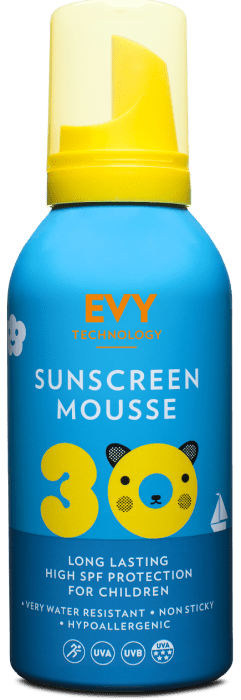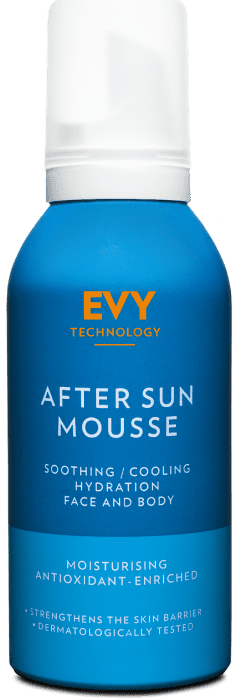- Apply before skin is exposed to the sun.
- Shake well and turn the bottle upside down.
- One handful of mousse is sufficient for one arm and the size of a golf ball for an adult’s face.
- Work the mousse between your hands to a more liquid form. Spread evenly and generously over the skin. Wait a few minutes until the mousse is dry before swimming or putting on clothes. Should be non-sticky after 5-10 mins. Otherwise you may have used too much.
- Sparing use noticeably reduces protection.
SPF 30 – Kids – 150ml
Sunscreen mousse
This protective and gentle EVY formula is developed for the most sensitive skin and can be used for children from 6 months of age. The unique technology makes it possible to obtain a mild but still a highly efficient and extra water resistant sunprotection. The formula is hypoallergenic and counteracts sun eczema and strengthens the skin barrier, which gives an efficient protection even against chlorinated- and saltwater. Free from preservatives, perfume, alcohol and nanoparticles. SPF 30 blocks about 97% of UVB rays when recommended amount is applied.
249 kr
EUR
In stock
- Very water resistant. The protection settles throughout the top layer of skin and does not drain.
- Absorbs quickly and makes it easier to obtain the recommended amount of sunscreen.
- 5 stars or maximum UVA protection acc. to UVA Boots Star Rating Test.
- Moisturises and strengthens the skin’s protective barrier against skin irritants, such as salt water and chlorinated water.
- Free from preservatives and perfume. No nanoparticles. Vegan.
- Does not clog pores and leaves no white residue.
- The packaging remains oxygen free and you do not have to throw away any rancid remains. Long-lasting and effective to the last drop.
- Resource-effective and kind to the environment.
- Recommended by dermatologist and skin care professionals.
Aqua. Butane. Propylene glycol. Octocrylene. Palmitic acid. Isobutane. Diethylamino hydroxybenzoyl hexyl benzoate. PVP/Hexadecene copolymer. Stearic acid. Butyl methoxydibenzoylmethane. PVP. Triethanolamine. Polysorbate 20. Ethylhexyl triazone. Dimethicone. Glycerin. Bis-ethylhexyloxyphenol methoxyphenyl triazine. Propane. Tocopherol. EAN 5694230167036
Is there any difference between kids and adult sunscreen protection?
Regular SPF 30 and 50 contain antioxidant supplements that work well against premature aging. Apart from that, it’s the same formula. The main reason why our children’s products have an adapted formula is to help the market and consumers to more easily identify a product that is suitable for and checked according to children’s needs. The feel of the mousse and the user-friendly formula are the same for all EVY products and can be used from 6 months. However, we recommend SPF 30 or higher for children under 16 years.
What sun filters are used in EVY products?
To provide the highest possible UVA and UVB protection, EVY products contain several different chemical sun filters, since different kinds of filters work in different ways. This allows us to reduce the concentration of the sun filters. The approved amount of sun filters is 25%. By using a small amount of each substance, the risks associated with a substance that usually has a maximum limit of about 10 percent of the concentration are minimized. This makes the products mild and hypoallergenic and can be recommended from 6 months of age. It is worth remembering that our chemical filters, and chemical filters in general, are organic/natural and consist of the elements, carbon, hydrogen, nitrogen and oxygen. They have been produced specifically to provide protection against UV radiation, unlike actual physical filters. The terms physical and chemical filters are often generalised, but in actual fact the issue is quite complex. Therefore, you should see each product in its own, unique light, and it is worth remembering that EVY is very different to regular sunscreen products, due to EVY’s patented basic formula.
UVA filter – Wavelength nm 280-400
Bis-ethylhexyloxyphenol methoxyphenyl triazine
UVA filter – Wavelength nm 310-400
Diethylamino hydroxybenzoyl hexyl benzoate
UVA filter – Wavelength nm 310-400
Butyl methoxydibenzoylmethane
UVB filter – Wavelength nm 290-350
Octocrylene
UVB filter – Wavelength nm 290-350
Ethylhexyl Triazone
What is the difference between physical and chemical /organic filters?
Physical filters like titanium dioxide and zinc oxide are finely ground, mineral-based particles with a distinguishable white membrane. However, the membrane can be reduced by applying it in nanoform. Even though they are minerals, they are not biodegradable. The advantage of physical filters is the low risk of allergies. Some people may react to chemical sun filters, as most brands contain large amounts.
The problem with physical nanoform filters is that they only provide a low level of UVA protection. Children and people with sensitive skin need especially strong UVA protection. Hence why most manufacturers use chemical filters which provide stronger UVA protection. Chemical filters do not have a white membrane or particularly sticky surface, and many people feel that they are easier to apply. However, we shouldn’t generalise too much about chemical sunscreens – there are about 30 different kinds and they all have unique properties.






There are no reviews yet.